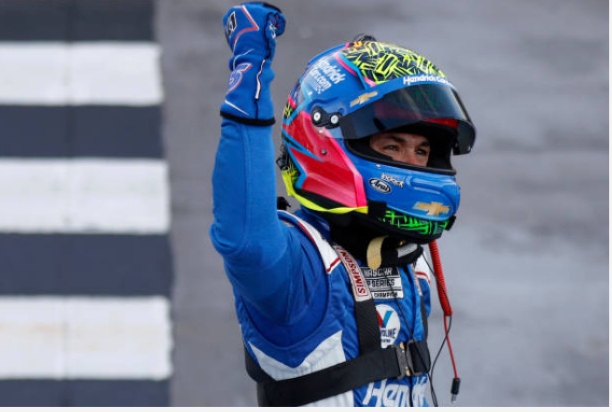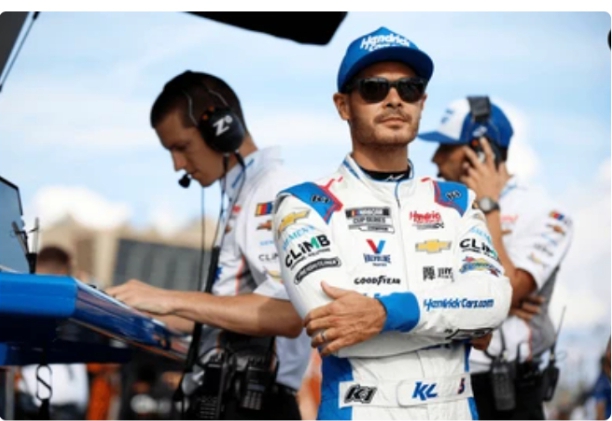
Kyle Larson Credits Mouthpiece Data for Sparking Key Changes at Watkins Glen
NASCAR champion Kyle Larson has long been known for his versatility and speed on the track, but now, his cutting-edge mouthpiece technology is helping shape the future of racecourse design. Larson’s biometric mouthpiece, which monitors G-forces and other physical data during races, has played a pivotal role in influencing changes at one of NASCAR’s most iconic tracks—Watkins Glen International.

In recent years, the use of data analytics has become increasingly important in motorsports. From tire wear to fuel strategy, teams rely heavily on data to improve performance. However, Larson’s use of a biometric mouthpiece takes this to a whole new level, providing insights into how the track affects drivers physically during a race.
The mouthpiece records crucial data points, such as head movement and G-forces exerted on the body during high-speed turns and collisions. This information is then analyzed by engineers and medical professionals to assess the physical strain drivers endure throughout the race. When Larson’s data revealed specific points of extreme G-force at Watkins Glen, it became clear that changes were necessary.
Known for its high-speed corners and elevation changes, Watkins Glen is already one of the more physically demanding tracks on the NASCAR calendar. Larson’s data highlighted certain areas where the forces exerted on drivers were especially intense, leading to discussions about potential safety risks and performance enhancements.

“Watkins Glen has always been a challenge, but this new data helped shine a light on areas where things could be improved—not just for safety, but for overall race flow,” Larson explained. “It’s great to see technology playing such a big role in making the track better for everyone.”
The insights derived from Larson’s mouthpiece data have been instrumental in initiating changes at Watkins Glen aimed at improving both driver safety and track performance. While the exact modifications are yet to be fully disclosed, there are speculations about tweaks to corner banking, runoff areas, and track surface improvements—all designed to reduce the physical toll on drivers without compromising the competitive nature of the circuit.
The changes at Watkins Glen could be a stepping stone for further innovations in NASCAR, where biometric data could lead to track modifications across other circuits, tailoring them not only for cars but also for the drivers behind the wheel.
The impact of Larson’s data-driven approach could herald a new era in motorsport, where driver feedback—both subjective and data-based—becomes a key factor in track design and improvement.
“Racing is evolving, and it’s exciting to be part of this new wave where driver input is helping to shape the tracks we race on. It’s a win for both the sport and the drivers,” Larson said.
As the sport continues to advance in its use of technology, Kyle Larson’s contributions through his biometric data might just be the tip of the iceberg for what’s to come in motorsport innovation.
Watkins Glen has always been an iconic track, but thanks to Kyle Larson’s high-tech input, it’s now on the cutting edge of safety and performance improvements, ensuring even more thrilling races in the future.
Related
Archives
Calendar
| M | T | W | T | F | S | S |
|---|---|---|---|---|---|---|
| 1 | 2 | 3 | 4 | 5 | 6 | 7 |
| 8 | 9 | 10 | 11 | 12 | 13 | 14 |
| 15 | 16 | 17 | 18 | 19 | 20 | 21 |
| 22 | 23 | 24 | 25 | 26 | 27 | 28 |
| 29 | 30 | 31 | ||||
Categories
- 2024 Australian Open
- 49
- 49ERS
- 49ers vs Lions
- 49ers vs. Chiefs
- 69ERS
- AFL
- AFLW
- American Football
- anonymous
- Arsenal
- Aston Villa
- AUSX 2024
- AUSX OPEN
- Baltimore Ravens
- Baseball
- Basketball
- Billionaires
- blog
- Books
- Boston Celtics
- Boxing
- Brisbane Bronco
- Buffalo Bills
- Canadian Football league
- Car Racing
- Caroline Panthers
- Celtics
- Championship
- Chelsea
- Chess
- Crystal Palace
- Cycling
- Dallas Cowboys
- Dallas Mavericks
- Dirt bike
- Djokovic
- Dodgers
- Dortmund
- Essendon Bombers
- Florida gators
- Football
- Fremantle Dockers
- Fullham
- general
- German Masters
- Giants pride
- Golden State Warriors
- Golf
- Hockey
- Houston Texans
- Indiana Fever
- Indiana Pacers
- Ipswich
- Ipswich Town
- Kansas city chiefs
- KYLE LARSON
- Lakers
- Larry bird
- LIFE STYLE
- LIFESTYLE
- Liverpool
- Los Angeles Dodgers
- Los Angeles Rams
- Mallas Cowboys
- Manchester city
- Manchester United
- Michealan Wolverines
- Michigan wolverine
- Michigan Wolverines
- Milwaukee brewers
- MLB
- MLB Aaron judge
- Motocross
- MotoGP
- Motorcross
- Music
- MXGP
- NASCAR
- NBA
- New England Patriots
- New Orleans pelicans
- Newcastle United
- NFC Championship
- NFL
- NFL Trade
- NHL
- Nottingham Forest
- Oil and Gas
- Olympic
- other
- Other Sports
- OU Softball
- PGA
- Philadelphia Eagles
- Philadelphia Flyers
- Philadelphia Phillies
- Pittsburgh Steelers
- Playoffs
- Racing
- Ravens smith
- Real Madrid
- Rugby
- San Francisco Fiants
- San Francisco Giants
- SEAL Team
- sevila
- Snooker
- Snooker Masters
- Sports
- St. Louis Cardinals
- Super Bowl LVIII
- Superbowl
- Supercross
- Ted Lasso
- Tennis
- TONY STEWART
- Toronto Raptors
- Tottenham Hotspur
- Tour de France
- Transfer News
- Uncategorized
- Video Games
- West ham
- Winnipeg Blue Bombers
- Wrexham
- WWE
Leave a Reply